Especially in a field such as customer service, where there is a definite need for a human touch. While machines do have the potential for higher accuracy and speed, there are still certain drawbacks that come with using machine learning instead of human interaction.
In this blog post, we will explore the pros and cons of replacing human interaction with machine learning in detail.
Pros of machine learning and AI
One of the primary benefits of using machine learning instead of human interaction is increased accuracy. Machines are able to analyze large amounts of data quickly and accurately without becoming tired or making mistakes due to personal biases.
A second major pro of replacing human interaction with machine learning could be a reduction in time spent performing routine tasks. By automating mundane tasks, more time is freed up to focus on more complex or creative endeavors. Automation can also help ensure accuracy and consistency throughout services such as customer support and data entry.
In addition, machines can continuously learn over time based on new information and data points, making them far more efficient than humans who must often be retrained in order to remain accurate.
This means that businesses that use machine learning can potentially save money in the long run by having fewer costly errors due to inaccurate input from their employees.
Another benefit of replacing human interaction with machine learning is increased speed. Machines are able to process large amounts of data much faster than humans can, allowing businesses to get work done more quickly and efficiently resulting in improved productivity overall.
Furthermore, machines don’t require breaks or vacation days like humans do so they can constantly continue working without interruption which further increases their efficiency.
Pros of human interaction
On the other hand, there are several challenges associated with replacing human interaction with machine learning as well. Most prominently, machines lack emotion and intuition which makes them unable to properly understand certain nuances that may require a more personalized approach such as customer service issues or complex problem-solving scenarios where creativity is required for optimal results.
Machine Learning lacks the empathy or creativity necessary to solve certain problems, making them inadequate when it comes to dealing with complex human emotions or situations that require deeper understanding.
Additionally, when utilizing complex algorithms it can often be difficult for non-experts to interpret their results accurately which could lead to missteps being taken by management simply because they weren’t able to understand what was going on behind the scenes correctly.
Furthermore, there is also a risk associated with trusting automated decisions too heavily without proper oversight from personnel who understand how the algorithms work in practice which could further lead to unintended consequences if not managed carefully enough.
Conclusion
In conclusion, there are both advantages and disadvantages associated with replacing human interaction with machine learning including increased accuracy and speed. However these should always be balanced against potential risks, such as lack of emotion or intuition.
Along with the difficulty in properly interpreting complex systems correctly, machine learning algorithms and AI should be supervised by experts who understand their inner workings properly.
Ultimately, it is important for us to consider the implications of replacing human interaction with machine learning carefully before implementing it into our daily lives. It will be up to businesses to decide whether or not these pros outweigh the cons for them in order to make an informed decision about their future operations.

